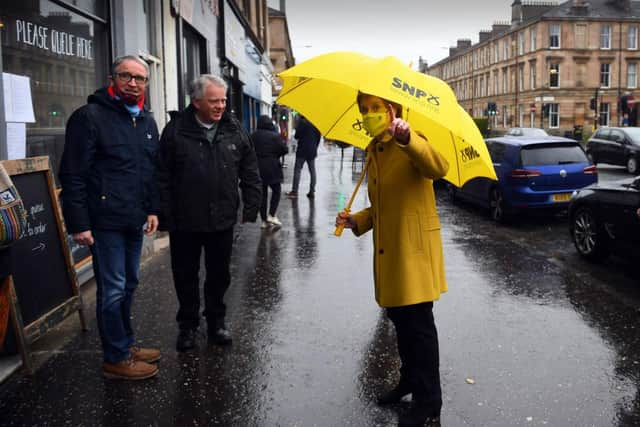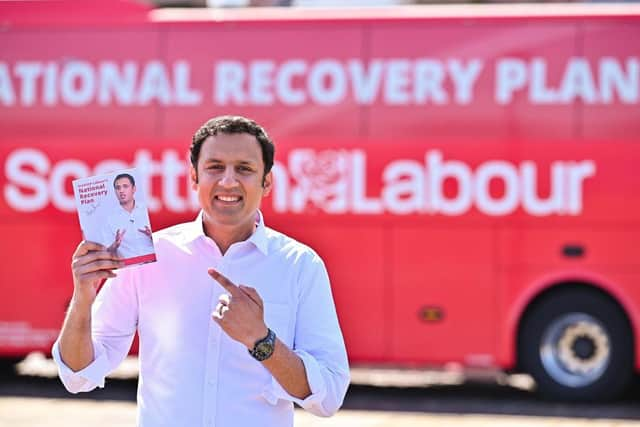Scottish election 2021: Top ten constituencies to watch at this year’s Holyrood vote
While the SNP are almost certain to win the most seats, stiff competition in some key constituencies threatens to prevent the party gaining an overall majority in Holyrood.
Here are ten of the most interesting constituency battlegrounds that could shape the overall result of this year’s election.
Aberdeen South and North Kincardine
•Winning party (2016): SNP
•Second Place (2016): Scottish Conservatives
•Swing to lose: 4.26%
Advertisement
Hide AdAdvertisement
Hide AdCreated in 2011 from two old Lib Dem strongholds - Aberdeen South, and West Aberdeenshire and Kincardine - the SNP’s Maureen Watt has held this seat at the last two elections. But the SNP could face a handy challenge from the Scottish Conservatives this time around.


The Tories came fourth behind Labour and the Lib Dems in 2011, but stormed into second place with a 19 per cent surge in its vote share in 2016. Then-Tory candidate Ross Thompson shredded Ms Watt’s 2011 majority of more than 6,000 votes - down to just 2,700. But, crucially, Mr Ross’ increased votes mostly came at the expense of the Lib Dems. The SNP vote actually went up slightly between 2011 and 2016.
If Liam Kerr, the new Tory candidate for Aberdeen South and North Kincardine wants to unseat Ms Watt, he will likely need to tap even deeper into the regions traditional Lib Dem support base.
Aberdeenshire West


•Winning party (2016): Scottish Conservatives
•Second place (2016): SNP
•Swing to lose: 1.28%
Something of a Frankenstein’s constituency, Aberdeenshire West was born in 2011, when officials stitched together chunks of two abolished seats - West Aberdeenshire and Kincardine, and Gordon (famously Alex Salmond’s old Holyrood stomping ground).
Although the region was long thought of as part of an “Orange Wall” of Lib Dem support, the newly-formed seat was snapped up by the SNP at the 2011 Scottish Parliament election.
Then in 2016, Alexander Burnett won the seat for the Scottish Tories.
The Eton-educated heir to the Barony of Kilduthie is sitting on a majority of just 900 votes, and will need to see off a strong challenge from the SNP’s former head of communications, Fergus Mutch.
Perthshire South and Kinross-shire
•Winning party (2016): SNP
•Second place (2016): Scottish Conservatives
•Swing to lose: 1.97%
Perthshire South and Kinross-shire is a predominantly rural constituency, with important links to Scotland’s livestock and fruit-growing markets.
Advertisement
Hide AdAdvertisement
Hide AdAnd the area has certainly been fertile ground for the SNP. In 1995, Roseanna Cunningham won the Westminster seat of Perth from the Scottish Conservatives, who had dominated there since the end of the Second World War.
Ms Cummingham retained Perth at the 1997 General Election, and went on to win the seat at the newly-formed Scottish Parliament two years later. Since then, she has been returned by constituents in 2003, 2007, 2011 - when Kinross was added after a boundary review - and in 2016 too.
But the Tories have never been far behind Ms Cunningham in their old haunt, and after she announced her retirement from Holyrood last year, her SNP successor Jim Fairlie is sure to face stiff competition.
Edinburgh Western
•Winning party (2016): Liberal Democrats
•Second place (2016): SNP
•Swing to lose: 3.72%
Edinburgh Western has been a target for both the SNP and the Liberal Democrats since it was created in 2011 following the boundary review. Its predecessor, Edinburgh West, returned a Lib Dem at every election since Holyrood reopened, while SNP candidates in the constituency gradually climbed from fourth in 1999, to third in 2003, and second in 2007.
The party actually managed to snap up the new seat of Edinburgh Western in 2011, before the Lib Dem’s Alex Cole-Hamilton won it back in 2016. Now sitting on a majority just shy of 3,000, the 43-year-old might fancy his chances of being returned this year too. But with the SNP intent on securing a Holyrood majority to press the case for a second independence referendum, the party will throw everything but the kitchen sink at seats like Edinburgh Western.
Dumfriesshire
•Winning party (2016): Scottish Conservatives
•Second place (2016): SNP
•Swing to lose: 1.70%
For years Dumfriesshire was considered a dependably red region of Scotland. Labour’s Elaine Murray won the now-defunct constituency of Dumfries at the three successive elections between the re-establishment of Holyrood in 1999, and the boundary review of 2008. Ms Murray even went on to win the newly-formed seat of Dumfriesshire in 2011, by a ten-point margin.
But in 2016, something strange happened. Labour were overtaken by not one, but two rival parties, when Mr Murray placed a distant third behind Scottish Conservative Oliver Mundell and the SNP’s Joan McAlpine. This time around, Dumfriesshire could end up being one of the most interesting constituency contests of the entire election.
Mr Mundell’s slender majority of just 1,230 will look tempting to the SNP - all the more so when they recall that Mr Mundell is a vocal Brexit supporter at a time when many voters see a route back to EU membership through Scottish independence.
Edinburgh Pentlands
•Winning party (2016): SNP
•Second Place (2016): Scottish Conservatives
•Swing to lose: 3.68%
Advertisement
Hide AdAdvertisement
Hide AdOriginally a Labour seat at Holyrood, the party have long since trailed the SNP and their main contenders, the Scottish Conservatives, in Edinburgh Pentlands.
The constituency is locked in a battle of the Gordons, as current SNP MSP, Gordon MacDonald, defends his 2,500 vote majority from the Tories’ Gordon Lindhurst.
Come polling day, Mr MacDonald’s position may well be safe as things stand - but an increased vote share for Mr Lindhurst could be a sign of stronger results elsewhere for the Tories.
Angus North and Mearns
•Winning Party (2016): SNP
•Second place: Scottish Conservatives
•Swing to lose: 4.21%
This region of Scotland has been a dependable SNP stronghold for decades. So much so that the party, which won the now-defunct Holyrood seat of Angus three consecutive times, went on to snap up both of the new seats that were carved out of it; Angus South, and Angus North and Mearns.
In 2011, the SNP stormed to victory in the latter with 54 per cent of the votes, but then seemed to stumble in 2016. The party’s Mairi Gougeon (née Evans) won the seat, but saw her vote share contract by more than nine percentage points. At the same time, Scottish Tory Alex Johnstone’s share surged by almost 12.
The result of the last contest leaves Ms Gougeon defending a majority of around 2,500 - hardly skin-of-your-teeth stuff, but not enormous either. If the Tories want to defy the polls and pull off an election upset, they could do worse than starting with seats like Angus North and Mearns.
North East Fife
•Winning party (2016): Liberal Democrats
•Second place (2016): SNP
•Swing to lose: 5.09%
A Liberal Democrats stronghold for decades, North East Fife has been solidly orange - with the exception of 2011 when the SNP’s Roderick Campbell won the seat - in every Scottish Parliamentary election since 1999.
Though now held by leader Willie Rennie after his 2016 victory, there is little doubt that North East Fife is back on the SNP’s target list. Mr Rennie has a fairly comfortable majority of around 3,500 - but his party has struggled in recent Scotland-wide polls - and the prospect of dislodging him is a highly attractive one to the First Minister and her allies.
Edinburgh Southern
•Winning party (2016): Scottish Labour
•Second place (2016): SNP
•Swing to lose: 1.47%
Advertisement
Hide AdAdvertisement
Hide AdLeafy Edinburgh Southern has changed hands more times than a rusty penny. Formerly Edinburgh South prior to the 2008 boundary review, the well-heeled suburban constituency is known for producing razor thin majorities. In 2003, Lib Dem stalwart Mike Pringle beat Labour’s Angus Mackay to win Edinburgh South by just 158 votes.
But it was the SNP’s (now Alba’s) Jim Eadie who won the newly-formed Edinburgh Southern in 2011, before Labour’s finance spokesman, Daniel Johnson, took it in 2016.
Mr Johnson, who sits on a majority just North of 1,000, is standing against Catriona MacDonald for the SNP, and Miles Briggs of the Scottish Tories.
Cowdenbeath
•Winning party (2016): SNP
•Second place (2016): Scottish Labour
•Swing to lose: 5.11%
Formerly part of the Dunfermline East constituency, which Scottish Labour consistently held before it was abolished in 2011, Cowdenbeath is currently in the hands of the SNP’s Annabelle Ewing.
The old mining town has never been particularly fertile ground for the Scottish Conservatives, and is likely to be a two-horse race between Ms Ewing, who sits on a majority of around 3,000, and Labour’s Alex Rowley - who lost the seat in 2016.
A strong election result for Labour could start in seats like Cowdenbeath, which the party will be eager to see return to its fold, but the SNP will take heart from their increasingly strong performance in polling of constituency votes.
A message from the Editor:
Thank you for reading this article. We're more reliant on your support than ever as the shift in consumer habits brought about by coronavirus impacts our advertisers.
If you haven't already, please consider supporting our trusted, fact-checked journalism by taking out a digital subscription.
Comments
Want to join the conversation? Please or to comment on this article.
